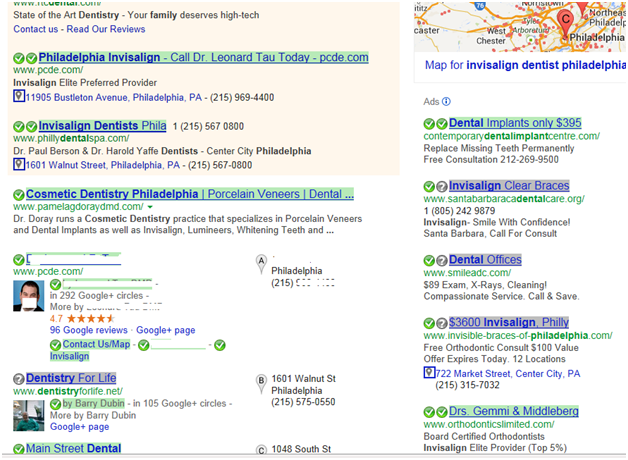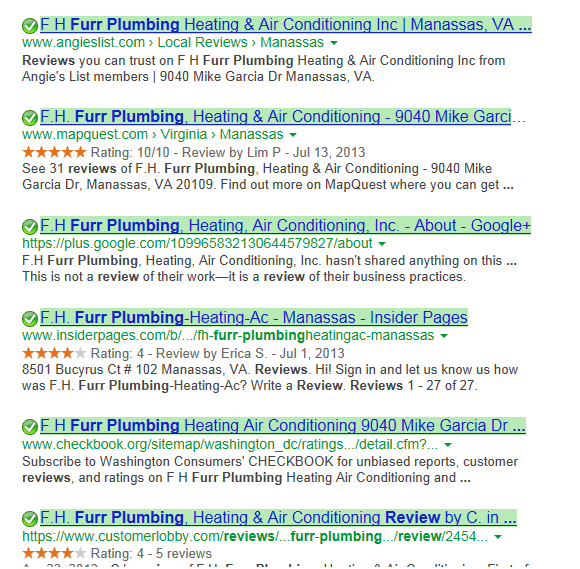Results
The Goal
The central objective of a reputation management system is to improve your online reputation, so that it drives more prospects to your business. The end result is getting more business, and we know the best online reputations get the most new business. This end result objective occurs through several elements, or steps, described here.
The Google Generic Search
When someone wants to purchase a new product or service, in a category where he or she does not have an existing supplier arrangement, he/she must go looking for a local vendor. When this is the case, he/she goes to Google and does a “Generic Search”. A Google generic search is one that takes the form “Plumber in Dayton, Ohio”, or “Roofing company in Somerville, MA”, or “Toyota Dealer in Northern, VA.” The key is that the buyer does not have an obvious vendor in mind, so he looks to see who is out there. Google reports that more than 25% of all its searches are local generic searches. And the numbers of searches being executed every day are staggering. In a given month, there could by 1,000 or 2,000 people doing a local generic search such as looking for a Toyota dealer in Atlanta, or some other common supplier category and location.
The results of a Google generic search usually appear in the form of a Map Pack. This is a Google result where five to ten businesses are listed on the left (after the paid ads), and are labeled A, B, C, etc. In addition, a map appears to the right with pins showing where A, B, C, etc. are located.
The first “sub-objective” of a reputation management system is to insure that your company is listed near the top or at the top of that Map Pack list. You want to be number 1. How do you get there?
First Get to the Top of the Google Rankings in Map Packs
In May of 2012, Google changed its search algorithm to make reviews much more important. It reasoned that its users did not just want to find a plumber for example, but the wanted to find the best plumbers. So reviews became much more important. So now there are five variables that Google considers in developing its rankings. SEO, which was all the rage five and ten years ago, is no longer enough. Here is what Google considers in determining rank.
- How well formed is the website?
- What are the relevant keywords in the website? How good is its SEO architecture?
- How “well documented” is the target company’s presence in the Internet? That is, have all the relevant sites been claimed by the company, and are all the company records at each site absolutely identical?
- How many reviews does the company have, and how good are those reviews?
Appearing at or near the top of the Map Pack list makes your company one of the first, if not the first one, that the new prospective buyer sees. By claiming all your relevant sites, and getting you a plethora of good reviews, we have gotten you to the top of the Map Pack list, so now you are the first company found by the researching buyer. Below is an example of part of a Map Pack display, where the first company listed, the A company, (a dentist in the Philadelphia area), uses our system. Note the circled A, B, and C in the lower middle of the page.
This user of the system has a lot of Google reviews, and an overall Google rating of 4.7. Because of that and other reasons, he appears as number one.
Second, Look Good in the Important Review Sites when the Buyer Researches your Online Reputation
Now that the prospective buyer has found your business, he/she is going to do more research. What most buyers want to know is what your online reputation is. They find that out by looking for reviews of your business. So they simply type into a Google search box your company name followed by Reviews. (e.g. Ace Plumbing Reviews). They will see a list of many different review sites that have reviews for that business. The key point is that all the reviews out there on your business are EASY TO FIND! Below is part of a Google listing from doing a Google search for “Furr Plumbing Reviews” (This is NOT a client). As you can see, the review sites Angies List, BBB, Insider Pages, MapQuest, Checkbook, Google+, and Customer Lobby sites are shown, and each has reviews on that business. Elsewhere, Yelp and Kudzu are shown.
Drown Out the Old Reviews with Good New Reviews
We are not able to erase your past bad reviews. But we are able to very much “drown them out” with newer good reviews. The older bad reviews fall far down on the list because of their old dates, and so they are rarely seen. Your current good reviews will dominate any search, because all the review sites give more relevance to recent reviews. So now that you have installed the system, your job is keep the good reviews coming, and don’t stop. The review sites always want current reviews. If you stop, your reviews will get old, and loose relevance.

